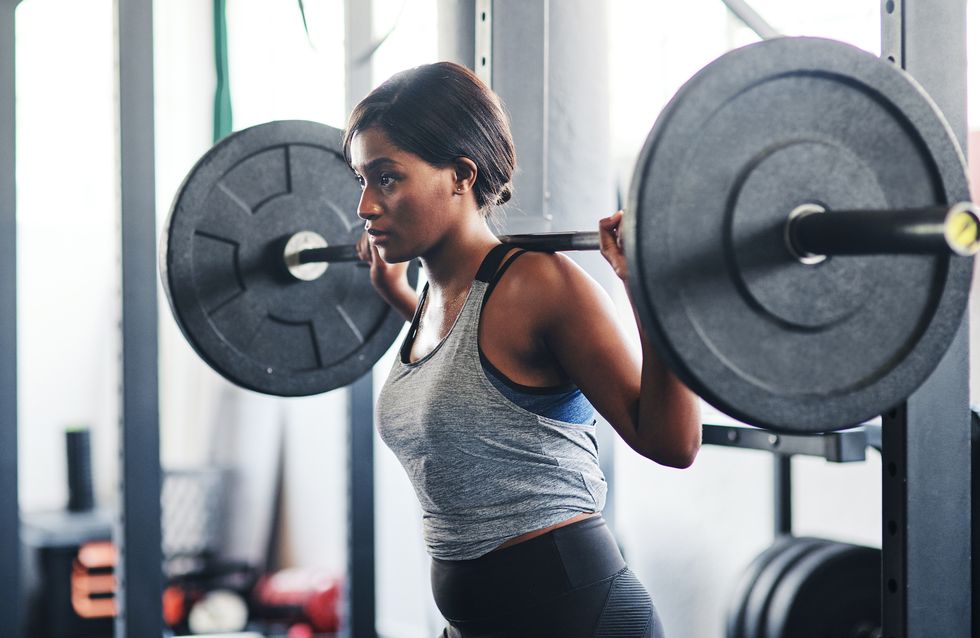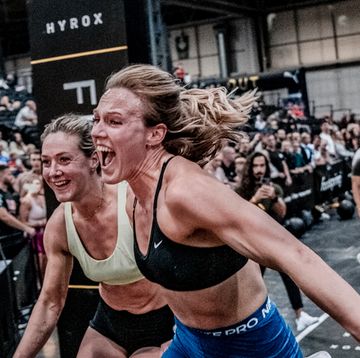Weight training is, increasingly, becoming a woman’s world, as females in gyms across the country are hitting the bar hard. And, whether you’re looking to improve your core strength, lift a little bit more than last time or even lose weight to reach a healthier weight, then weight training is an ideal solution. (Reminder: you should never want to lose weight for anyone other than yourself – all bodies are worthy of love – and it's always best to chat it through with your GP first).
"The main mistake that people make when it comes to resistance training and weight loss revolves around confusion about what resistance training actually does," explains Emily Servante, Trainer Education Manager at Ultimate Performance. "The only thing that can cause us to gain, maintain or lose weight is energy balance. So, if we eat more calories than we burn, we gain weight; if we eat fewer calories than we burn, we lose weight."
"If you ask most women about their fitness goals, they’ll say they want to look more ‘toned’. In its purely medical definition, muscle ‘tone’ means continuous and passive contraction of a muscle, so in this sense, unless you’re completely bed-bound and unable to move, you’ve already nailed this," she adds. "What people [actually] mean is that they want to improve their body composition, which means reducing body fat levels while maintaining muscle mass."
In addition to making you fitter and stronger overall, strength training can help to have a positive impact on your bone density, reducing your chances of developing osteoporosis, and some research even suggests that it could lower your risk of type 2 diabetes and cardiovascular disease.
So, how do you do this? Here are seven simple ways to kick-start your weight-lifting or weight-loss journey.
1) Start slow
"Lifting weights is an advanced skill and, just as you wouldn’t start learning the piano and expect to be Mozart in three weeks, you need to recognise that lifting weights is much the same (except you’ve started learning around ten instruments at once!)," admits Emily.
So, how quickly can you expect to start seeing improvement? "At the start, most of your gains will be neurological, meaning that you’re just getting better at the movement pattern itself. When you first start lifting, it’s not uncommon for you to increase weights session to session.
"However, as you become more advanced, this will change. You’ll see improvement week to week or month to month. Don’t worry about doing every fancy new move you see on Instagram! Pick a few key movements that allow you to work each muscle group in a stable environment and get progressively stronger in them over time. Keep it simple!"
2) Invest in guidance
Personal training = £££, but a little bit of tuition can greatly reduce your chance of doing yourself more harm than good - and frankly, that makes the upfront spend worthwhile. At the very least, Emily recommends asking someone to show you a few key moves and how to use the weights machines initially. "It’s vital you get the technique right - at best you won’t make any gains, at worst you could seriously injure yourself," she explains. If you’re really not up for a one-on-one sesh, you could consider joining a class instead - an increasing numbers of gyms are offering lessons in lifting, in order to teach you to use weights safely.
So, how do you select a PT? Emily suggests that if you’re not sure who to choose, watch the trainers in your gym carefully. "Choose a trainer who is 100% focused on their client, who isn’t afraid to get in and physically adjust or spot the client until they achieve the right technique, or call an unsafe set. Most of all, look for someone who cares. With some patient observations, you’ll soon be able to suss who is and isn’t the right fit for you. And, don’t be afraid to shop around for help."
3) Lift heavy
The main priority is to nail your technique before progressing. But, once you’ve established a baseline, you can start to figure out if you’re ready to increase your weights.
"Bicep curling 2kg a few times is not going to do anything for you - sorry!" Emily says. Turns out you need to be doing what the pros call "lifting to failure" - if you get to your third set of 10 repetitions, you need to be only making 7 or 8 at the most. If you’re finding it easy, it’s a sign that you need to add more weight.
4) Use your time wisely
Training frequency completely depends on the individual and their goal. For example, some people may like training five times a week (at the more extreme end of the scale), whereas three times may be a struggle for others. As a reminder, the NHS recommends 150 minutes of moderate intensity activity, or 75 minutes of vigorous intensity activity a week. The main consideration in any training plan is adherence – can you stick to it? You could have the most 'optimal' plan in the world, but it's useless if it just doesn't work for you and your lifestyle.
Most of us don't have time to spend hours on a workout every day, but with weight training, that's not necessary; you just need to identify the moves that will get you to where you want to be, and make them your priority. "The main focus for building and retaining muscle? Creating progressive overload. This means that you’re continually increasing the challenge to your muscles over time. We do so by increasing our training volume to trigger 'functional overreaching'. This means creating enough stimulus to push you beyond your comfort zone, but not so much that you become overtrained."
5) Eat enough protein
Protein is essential for building muscle, so eating a diet that’s rich in lean meats, fish, eggs, beans, nuts and pulses should be a big part of your training plan - Emily recommends that you aim for 2-3 good quality portions of lean protein every day. "When we are in a calorie deficit, our protein requirements increase slightly to offset the risk of muscle loss," she explains. "Alongside resistance training, adequate protein intake is one of the key ways to minimise muscle loss during a diet. So, if your goal is to look leaner and gain more definition, it’s definitely something you should prioritise. For the majority of people, anywhere between 2.2. to 2.8 grams of protein per kilo of lean body mass (not total body weight) is about right."
But, what if you’re a vegetarian or vegan? "While many non-animal products contain protein, they don’t contain these amino acids in sufficient amounts for us to make full use of the protein they contain," says Emily. So, go for protein and amino acid heavy choices.
6) Be in a calorie deficit
"Sadly, the quickest and easiest way to lose weight is still to eat less than you burn," Emily advises. "It used to be said that you couldn’t build muscle in a calorie deficit, but increasing research shows that’s not the case. You can still reduce your calorie intake and make some great gains in calorie-consuming muscle at the same time."
The NHS states that the average woman can lose weight at a steady rate eating around 1400 calories a day, but this will depend on your starting weight, height and activity levels, amongst other things. Seek the advice of your doctor if you’re unsure what’s right for you.
7) Get ready for sore arms
No pain, no gain, right? "DOMS, or delayed onset muscle soreness, occurs when there is muscle damage, which typically happens when you do something particularly new or intense. As a result, being sore is not indicative of growth, so you shouldn’t chase it in your workouts," says Emily. "The good news is that the longer you lift, the less intense this sensation becomes, so stick with it, and it will get better." Ideally, you’ll wait at least 48 hours between training each body part. But, staying hydrated, gentle walking and plenty of veggies can help DOMS improve quicker.
Ready to get started?
Sold on weight training? We asked Emily for the best advice to get started. "If you don’t have much time, focus on big compound moves that use lots of muscles," Emily suggests. "Deadlifts, squats, and pull-ups are all great for working on big, important muscle groups. Stick with these exercises for long enough to get strong in them and remember that results take time!"















